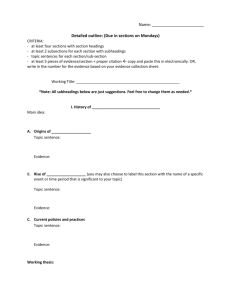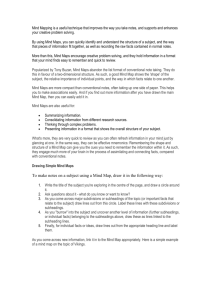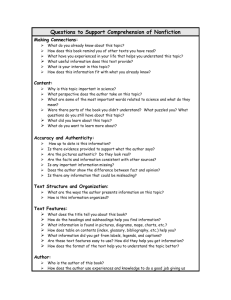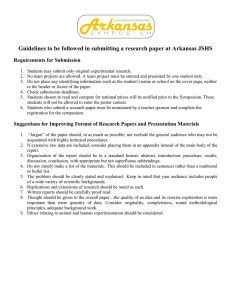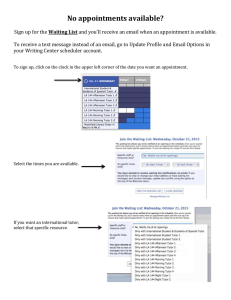Document 13525823
advertisement
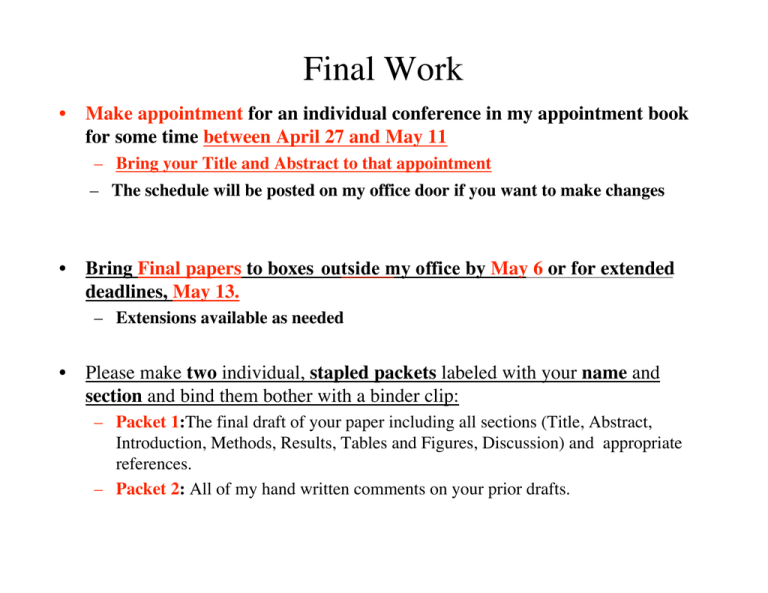
Final Work • Make appointment for an individual conference in my appointment book for some time between April 27 and May 11 – Bring your Title and Abstract to that appointment – The schedule will be posted on my office door if you want to make changes • Bring Final papers to boxes outside my office by May 6 or for extended _____________________________________________________________________ deadlines, May 13. – Extensions available as needed • Please make two individual, stapled packets labeled with your name and section and bind them bother with a binder clip: – Packet 1:The final draft of your paper including all sections (Title, Abstract, Introduction, Methods, Results, Tables and Figures, Discussion) and appropriate references. – Packet 2: All of my hand written comments on your prior drafts. Matters of Format • Title page: Title, author, affiliation, key words, word count, running title • Header or footer on every page including name, running title, and page number • Laser quality print • Time or Times New Roman font • 12 pt • Standard manuscript paper 81/2 x 11 • 1 side of paper • 1 column • Double spaced • Ragged right • 1-inch margins • Binder clip (no report covers) • Hand drawn graphics ok • Keep a copy Make Structure Obvious Abstract Introduction Methods Major headings bold, large font, left justified Subheadings bold but smaller font and indented Subheadings Subheadings Results Subheadings Subheadings Discussion Conclusion When you use subheads, there should be at least two of them Put all illustrations at the end of the document Meeting 6: Title and Abstract A title labels a research paper. An abstract is a stand alone miniversion of a research paper. What is the Purpose of a Title? What is the Purpose of a Title? Indicate the subject of your research. Distinguish your research from others of its kind. Show continuity with preceding papers. Provide key words for indexing. Rules of Thumb for Titles Use a minimum of technical terminology. Use fewer than 80 characters. Avoid active verbs, numerical values, abbreviations, and punctuation. Some Bad Titles Studies on Brucella Action of Antibiotics on Bacteria On the addition to the method of micrscopic research by a new way of producing color-contrast between an object and its background or between definite parts of the object itself Isolation of Antigens from Monkeys Using Complement-Fixation Techniques Using a Fiberoptic Broncoscope, Dogs Were Immunized With Sheep and Red Blood Cells Some Good Titles The role of ARK in stress-induced apoptosis in Drosophila cells Use of double-stranded RNA interference in Drosophila cells lines to dissect signal transduction pathways What’s a Running Title? Shorter version of the title printed at the top of each page to save space. Also called a “running head.” Maximum character count given in instruction to authors. Best to write it yourself. What is the Purpose of an Abstract? What is the Purpose of an Abstract? A stand alone, miniversion of the paper (250 words or less). Summarizes the main sections of the paper. States the purpose, findings, and impact of the work. Economy of Words Provide an abstracted version of your paper in as few words as possible. Choose each word carefully. Make them clear and significant. Provide only the key points. What are Some Pitfalls of Titles? Too general or too specific. Too long or too short. Incomprehensible (sometimes from the use of jargon). Inaccurate (often a syntax problem). Contains abbreviations, chemical formulas, jargon. What are Some Pitfalls of Abstracts? Extraneous detail or information or conclusions not stated in the paper. Wrong type (informative versus descriptive). Contains abbreviations, chemical formulas, jargon or references to the literature, tables, or figures. Failure to state the purpose of the work at the outset. Failure to state the importance of the work and where it leads at the end. Abstract Checklist Every abstract has a little: Introduction Methods Results Discussion Conclusion State the purpose at the outset. Make the bottom line of your Abstract resonate with the bottom line of your discussion (but they should not be identical). Today’s In-class Exercises Critique SciComm in essay form: What’s distinctive? what’s something positive? what’s something that could be improved? Make an appointment to see me sometime between April 30 and May 13. Out-of-Class Exercises Write a title and abstract for your long-term project and bring it to my office at the appointed time. Modify previous sections as needed.
